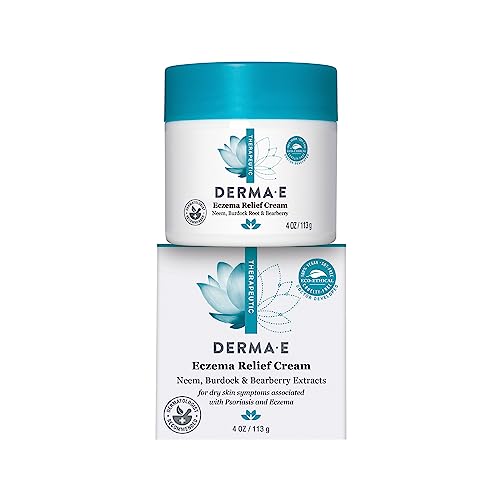
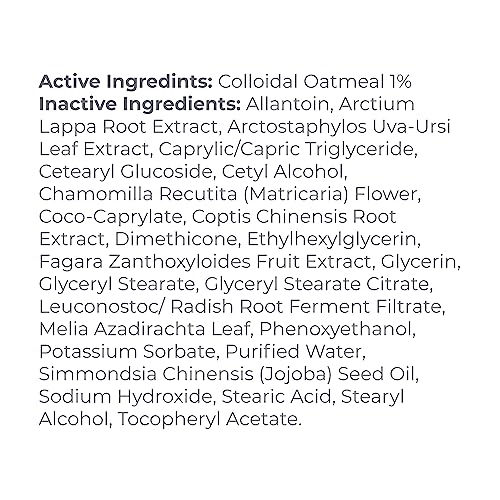
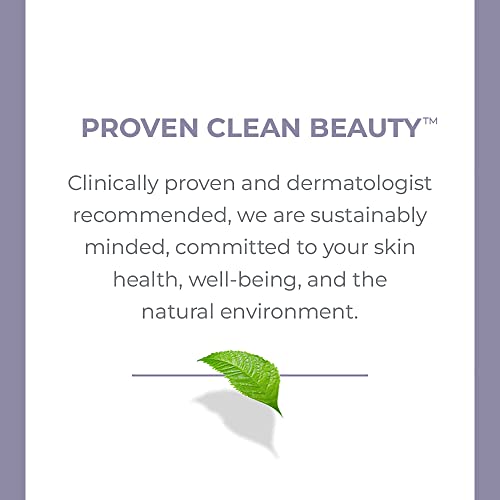
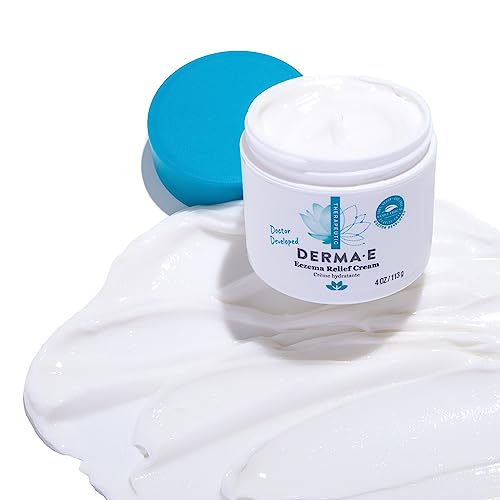
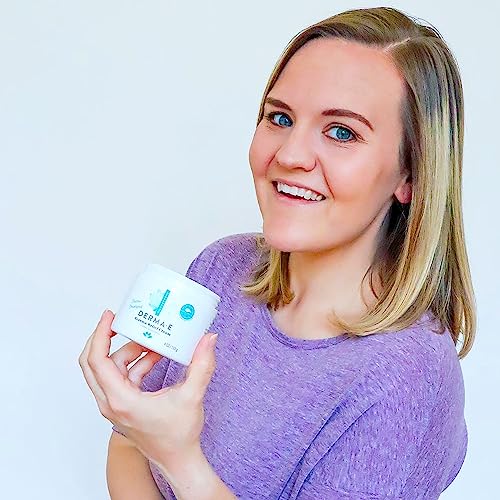
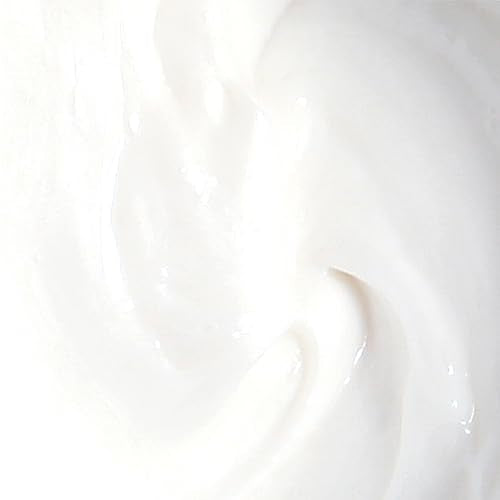
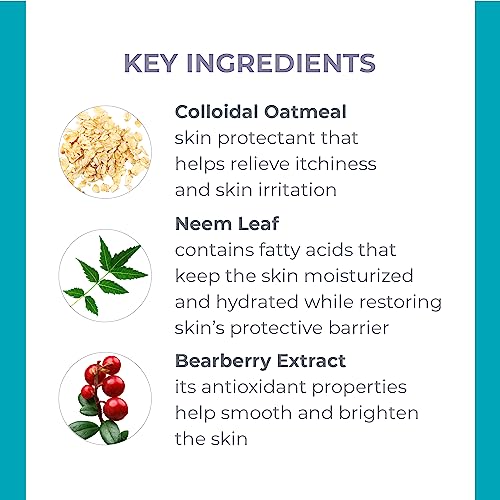
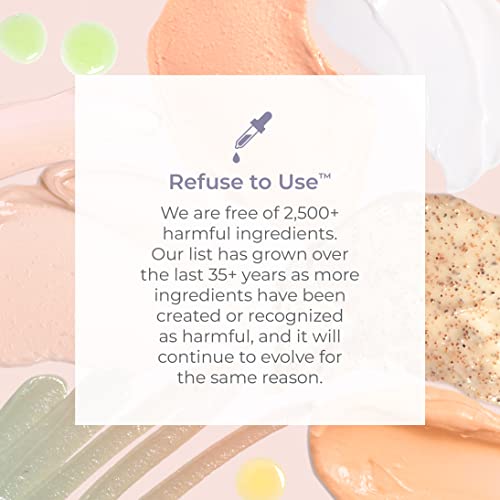
Derma E Eczema Relief Cream - Natural Itch & Dry Skin Relief, Moisturizing Botanicals - 4oz


Sodium Hydroxide
High RiskSodium hydroxide is a highly caustic and reactive inorganic compound commonly used as a pH adjuster in various products. It is effective in neutralizing acids and plays a role in the production of soaps and detergents.
Sustai Insights
Sodium hydroxide serves essential functions, particularly in adjusting pH levels, but poses significant health risks, including skin and eye irritation. It is subject to high usage restrictions due to its corrosive nature. Environmental concerns include its potential to pollute water sources and contribute to ecosystem damage. Regulatory bodies have imposed strict guidelines on its use, indicating a high-risk profile for products containing this ingredient. Safe handling practices are crucial, and alternatives include milder pH adjusters, emphasizing the need for caution in its application.
Phenoxyethanol
Medium RiskPhenoxyethanol is a preservative used in cosmetics and personal care products to prevent microbial growth and extend shelf life. It is commonly found in formulations such as lotions, creams, and serums.
Sustai Insights
Phenoxyethanol serves effectively as a preservative, ensuring product stability and safety by inhibiting microbial growth. It is considered to have low health risks regarding carcinogenicity, allergies, and reproductive toxicity. However, moderate use restrictions exist, and regulatory bodies have advised caution in specific applications. Environmental concerns include its potential as a pollutant, although it is not highly bioaccumulative. Overall, the ingredient presents a medium risk level, with safe usage practices recommended and alternative preservatives available for those seeking greener options.
Dimethicone
Medium RiskDimethicone, also known as polymethylsiloxane, is a silicone-based polymer commonly used in personal care products for its smooth application and skin conditioning properties. It acts primarily as an emollient, providing a silky feel while forming a protective barrier on the skin.
Sustai Insights
Dimethicone provides functional benefits as an effective emollient and skin protectant, contributing to product stability and sensory attributes. It is considered low risk for carcinogenicity, allergies, and reproductive toxicity, but has moderate usage restrictions due to environmental persistence and bioaccumulation concerns. Regulatory bodies have issued advisories regarding its use in certain formulations. Overall, its risk level is assessed as medium, and users are advised to follow recommended usage practices. Alternatives like natural oils or butters may offer sustainable options.
Tocopheryl Acetate
Medium RiskTocopheryl acetate is a chemical compound that serves primarily as a form of Vitamin E. It is used in cosmetic and personal care products for its antioxidant properties and to enhance skin stability and moisture.
Sustai Insights
Tocopheryl acetate is valued for its functional benefits, including acting as an antioxidant and skin conditioning agent. It is generally considered to have low carcinogenicity and reproductive toxicity risk, although it poses a moderate concern for allergies. Environmental risks are minimal, with no significant pollutant or bioaccumulation potential noted. Regulatory bodies have not imposed significant restrictions. Safe usage practices should be followed, particularly regarding enhanced skin absorption. Alternatives like natural Vitamin E may provide similar benefits with potentially lower allergenic properties. Overall, this ingredient presents a medium risk assessment.
Potassium Sorbate
Medium RiskPotassium sorbate is a potassium salt of sorbic acid, primarily used as a preservative in food and cosmetic products. It inhibits the growth of molds, yeast, and some bacteria, extending the shelf life of products. It is commonly found in various formulations due to its effectiveness and low toxicity.
Sustai Insights
Potassium sorbate serves as an effective preservative, preventing microbial growth in food and cosmetic products, which is vital for safety and longevity. Although it has a low risk of carcinogenicity and developmental toxicity, there is a moderate concern regarding allergies and immunotoxicity. Environmentally, it poses minimal risks as it is not significantly bioaccumulative. Regulatory agencies have verified its use, although some products may face restrictions. Overall, it is assessed as a medium risk ingredient, with safe usage practices recommended, and alternatives such as natural preservatives could be considered.
Simmondsia Chinensis (Jojoba)
Low RiskSimmondsia chinensis, commonly known as jojoba, is an oil derived from the seeds of the jojoba plant. It is commonly used in cosmetic formulations for its moisturizing properties, acting as an emollient and skin conditioning agent.
Sustai Insights
Jojoba oil offers functional benefits such as effective skin moisturization and is biodegradable, with sustainable sourcing practices. Health risks are low, with minimal concerns regarding carcinogenicity, allergies, and reproductive toxicity. Environmental impact is negligible, with no pollutant or bioaccumulation potential. Regulatory status is favorable with no significant restrictions noted. Overall, it is assessed as low risk, and safe usage practices should be maintained. Alternatives include other plant-derived oils like argan or almond oil, which may provide similar benefits.
Stearic Acid
Low RiskStearic acid is a naturally occurring fatty acid commonly found in animal and vegetable fats. It functions primarily as an emulsifier, thickener, and stabilizer in cosmetic and personal care products, providing texture and consistency.
Sustai Insights
Stearic acid offers functional benefits such as effective emulsification and stabilization of formulations. It is derived from renewable sources and is biodegradable, contributing to its sustainability profile. Health risks are low, with minimal concerns regarding carcinogenicity, allergies, or reproductive toxicity. Environmental risks are also low, with no significant pollutants or bioaccumulation concerns noted. Regulatory bodies, including the FDA, do not impose restrictions on its use. Overall, stearic acid is assessed as low risk, and its safe usage practices are well-established, with no significant alternatives needed.
Isostearyl Sebacate
Low RiskIsostearyl sebacate is a synthetic ester derived from isostearyl alcohol and sebacic acid. It serves primarily as an emollient and skin conditioning agent in cosmetic formulations, contributing to product spreadability and moisturizing properties.
Sustai Insights
Isostearyl sebacate offers functional benefits as a skin conditioning agent and emollient, enhancing product texture and moisture retention. It has low health risks, with minimal concerns regarding carcinogenicity, allergenic potential, and reproductive toxicity. Environmentally, it does not pose significant pollution or bioaccumulation risks. Regulatory status is generally favorable, with low restrictions noted. Overall, it presents a low risk profile, making it a suitable ingredient in cosmetic products.
Glyceryl Stearate Citrate
Low RiskGlyceryl stearate citrate is a citric acid ester of glycerol and stearic acid, commonly used as an emulsifier and stabilizer in cosmetic formulations. It helps blend oil and water components, enhancing product texture and consistency.
Sustai Insights
Glyceryl stearate citrate offers functional benefits as an effective emulsifier, improving product stability and texture. It is considered safe, with low concerns for cancer, allergies, and reproductive toxicity. However, it may cause skin irritation in some individuals. Environmental risks are minimal, with no significant bioaccumulation or pollutant potential. Regulatory bodies have not placed significant restrictions on its use. Overall, the ingredient is assessed as low risk, with safe usage practices recommended, and alternatives may include other emulsifiers like cetearyl alcohol.
Ethylhexylglycerin
Low RiskEthylhexylglycerin is a glyceryl ether utilized primarily as a skin-conditioning agent and preservative in cosmetic formulations. It enhances the efficacy of preservatives and serves as a humectant, helping to retain moisture in the skin. This ingredient is commonly found in various personal care products.
Sustai Insights
Ethylhexylglycerin offers functional benefits as an effective preservative and skin-conditioning agent, contributing to product longevity and moisture retention. Health risks are generally low, with minor concerns regarding allergic contact dermatitis and irritant potential. Environmentally, it poses minimal risks, not being recognized as a pollutant or bioaccumulative. Regulatory bodies have imposed few restrictions, indicating its safety for use. Overall, its risk level is assessed as low, making it a viable option in cosmetic formulations. For those seeking alternatives, ingredients like propanediol may serve similar functions with potentially lower irritation profiles.
Leuconostoc/Radish Root Ferment Filtrate
Low RiskLeuconostoc/radish root ferment filtrate is a natural fermentation product derived from radish roots, commonly used in skincare for its potential preservative properties and skin-conditioning benefits. It functions by harnessing the metabolic activity of Leuconostoc bacteria to provide a source of beneficial compounds.
Sustai Insights
This ingredient offers functional benefits, primarily as a preservative and skin-conditioning agent, while being biodegradable and sustainably sourced. Health risks are generally low, with no significant concerns regarding carcinogenicity or allergies, though contamination concerns exist. Environmentally, it poses minimal risks, categorized as low overall risk based on current scientific consensus. Safe usage practices are advised, and alternatives may include other natural preservatives like tocopherol or rosemary extract.
Cetyl Alcohol
Low RiskCetyl alcohol is a long-chain organic alcohol commonly used in cosmetic formulations. It serves as an emollient, emulsifier, and thickening agent, enhancing the texture and stability of products. Cetyl alcohol is derived from natural sources, such as coconut or palm oil, and is often included in creams, lotions, and hair conditioners.
Sustai Insights
Cetyl alcohol offers functional benefits as an emollient and emulsifier, improving product texture and stability. It is biodegradable and sourced from renewable materials, contributing to sustainability. Health risks are minimal, with low concerns for carcinogenicity, allergies, or reproductive toxicity. Environmental impact is also low, with no significant pollutant or bioaccumulation potential. Regulatory bodies have not placed restrictions on its use, indicating a favorable safety profile. Overall, cetyl alcohol is assessed as low risk, and safe usage practices include ensuring proper formulation concentrations.
Cetearyl Glucoside
Low RiskCetearyl glucoside is a surfactant and emulsifier derived from natural sources, commonly used in cosmetic and personal care products to stabilize formulations and enhance texture. It helps to blend oil and water-based ingredients, improving product consistency and application.
Sustai Insights
Cetearyl glucoside offers functional benefits as an effective emulsifier and surfactant, facilitating product stability. Its sustainability credentials are notable, as it is biodegradable and sourced from renewable materials. Health risks are generally low, with minimal concerns for irritation and allergies. Environmental impacts are also low, posing no significant pollution or bioaccumulation risks. Regulatory status remains positive with no major restrictions reported. Safe usage practices are advised, and alternatives such as plant-derived emulsifiers may be considered. Overall, the risk level associated with cetearyl glucoside is low.
Stearyl Alcohol
Low RiskStearyl alcohol is a compound produced from the hydrogenation of stearic acid, commonly used in cosmetic formulations as an emulsifier and thickening agent. It helps stabilize products by blending oil and water phases, enhancing texture and consistency.
Sustai Insights
Stearyl alcohol provides functional benefits as an emulsifier and stabilizer, contributing to improved product texture. It is generally regarded as safe with low concerns for cancer, allergies, and reproductive toxicity. However, it may cause moderate skin, eye, or respiratory irritation. Regulatory bodies do not impose significant restrictions, indicating a low overall risk. While it poses minimal health and environmental hazards, caution is advised for sensitive individuals. Alternatives like cetyl alcohol or plant-based emulsifiers may offer safer options for formulators.
Vegetarian Glycerin
Low RiskVegetarian glycerin, also known as glycerol, is a colorless, odorless, and viscous liquid derived from plant sources. It is primarily used as a humectant, solvent, and emollient in various personal care products, helping to retain moisture and improve texture.
Sustai Insights
Vegetarian glycerin offers functional benefits as an effective humectant, promoting hydration and skin smoothness. It is biodegradable and typically sustainably sourced. Health risks associated with glycerin are low, with no significant concerns for carcinogenicity, allergens, or reproductive toxicity. Environmental risks are minimal, and it is not subject to major regulatory warnings. Overall, the risk level for this ingredient is low, making it a safe choice in formulations. Safe usage practices include ensuring proper concentrations in products, and alternatives such as propylene glycol exist but may have differing properties.
Coptis Chinensis Root Extract
Low RiskCoptis chinensis root extract is an extract derived from the root of the Coptis chinensis plant, commonly used in various products for its potential health benefits and functional properties. It is often included for its antioxidant and antimicrobial properties.
Sustai Insights
Coptis chinensis root extract offers functional benefits such as antioxidant and antimicrobial effects, contributing to product stability. It is considered sustainable and does not present significant health risks, including carcinogenicity or allergenic potential. There are no notable environmental hazards associated with its use. Regulatory bodies currently do not impose restrictions on this ingredient, leading to an overall low risk assessment. Safe usage practices should be followed, although alternatives are limited. Overall, this ingredient is evaluated as low risk.
Azadirachta Indica (Neem) Leaf
Low RiskAzadirachta indica, commonly known as neem, is derived from the leaves of the neem tree. It is primarily utilized for its potential antimicrobial, anti-inflammatory, and insecticidal properties in various personal care and agricultural products. This ingredient is often included for its natural efficacy in promoting skin health and pest management.
Sustai Insights
Neem leaf offers several functional benefits, including antimicrobial and anti-inflammatory properties, making it valuable in personal care formulations. It is sustainably sourced and biodegradable, contributing positively to environmental health. Health risks associated with neem leaf are low, with minimal concerns regarding carcinogenicity, allergies, or reproductive toxicity. Regulatory status indicates it is not banned or restricted in major markets. Overall, the risk level is considered low, making neem leaf a viable ingredient, though safe usage practices should be followed.
Caprylic Triglyceride
Low RiskCaprylic triglyceride is an ester derived from coconut oil and glycerin, commonly used in cosmetic formulations as an emollient, stabilizer, and skin-conditioning agent. It helps to improve the texture and spreadability of products while providing a lightweight, non-greasy feel.
Sustai Insights
Caprylic triglyceride offers functional benefits such as enhanced skin moisturization and improved formulation stability. It is generally regarded as safe, with low concerns regarding carcinogenicity, allergenic potential, and reproductive toxicity. Environmental impact is minimal, with no significant pollutant or bioaccumulative properties identified. Regulatory bodies have not issued warnings or restrictions. Overall, the risk level is low, making it a suitable ingredient in cosmetic products. Safe usage practices include adhering to recommended concentrations, and while there are alternatives, caprylic triglyceride remains a reliable choice.
Allantoin
Low RiskAllantoin is a naturally occurring nitrogenous compound found in various plants and animals. It is commonly used in cosmetic formulations for its soothing and moisturizing properties, as well as its ability to promote skin cell turnover and healing.
Sustai Insights
Allantoin offers functional benefits such as skin soothing, hydration, and promoting cell regeneration. It is generally recognized as safe, with low concerns regarding carcinogenicity, allergies, and reproductive toxicity. Environmentally, it poses minimal risks, being biodegradable and sustainably sourced. Regulatory bodies do not impose significant restrictions on its use. Overall, the risk level associated with allantoin is low, making it a favorable ingredient in personal care products.
Phenoxyethanol
Medium RiskPhenoxyethanol is a preservative used in cosmetics and personal care products to prevent microbial growth and extend shelf life. It is commonly found in formulations such as lotions, creams, and serums.
Sustai Insights
Phenoxyethanol serves effectively as a preservative, ensuring product stability and safety by inhibiting microbial growth. It is considered to have low health risks regarding carcinogenicity, allergies, and reproductive toxicity. However, moderate use restrictions exist, and regulatory bodies have advised caution in specific applications. Environmental concerns include its potential as a pollutant, although it is not highly bioaccumulative. Overall, the ingredient presents a medium risk level, with safe usage practices recommended and alternative preservatives available for those seeking greener options.
Dimethicone
Medium RiskDimethicone, also known as polymethylsiloxane, is a silicone-based polymer commonly used in personal care products for its smooth application and skin conditioning properties. It acts primarily as an emollient, providing a silky feel while forming a protective barrier on the skin.
Sustai Insights
Dimethicone provides functional benefits as an effective emollient and skin protectant, contributing to product stability and sensory attributes. It is considered low risk for carcinogenicity, allergies, and reproductive toxicity, but has moderate usage restrictions due to environmental persistence and bioaccumulation concerns. Regulatory bodies have issued advisories regarding its use in certain formulations. Overall, its risk level is assessed as medium, and users are advised to follow recommended usage practices. Alternatives like natural oils or butters may offer sustainable options.
Simmondsia Chinensis (Jojoba)
Low RiskSimmondsia chinensis, commonly known as jojoba, is an oil derived from the seeds of the jojoba plant. It is commonly used in cosmetic formulations for its moisturizing properties, acting as an emollient and skin conditioning agent.
Sustai Insights
Jojoba oil offers functional benefits such as effective skin moisturization and is biodegradable, with sustainable sourcing practices. Health risks are low, with minimal concerns regarding carcinogenicity, allergies, and reproductive toxicity. Environmental impact is negligible, with no pollutant or bioaccumulation potential. Regulatory status is favorable with no significant restrictions noted. Overall, it is assessed as low risk, and safe usage practices should be maintained. Alternatives include other plant-derived oils like argan or almond oil, which may provide similar benefits.
Stearic Acid
Low RiskStearic acid is a naturally occurring fatty acid commonly found in animal and vegetable fats. It functions primarily as an emulsifier, thickener, and stabilizer in cosmetic and personal care products, providing texture and consistency.
Sustai Insights
Stearic acid offers functional benefits such as effective emulsification and stabilization of formulations. It is derived from renewable sources and is biodegradable, contributing to its sustainability profile. Health risks are low, with minimal concerns regarding carcinogenicity, allergies, or reproductive toxicity. Environmental risks are also low, with no significant pollutants or bioaccumulation concerns noted. Regulatory bodies, including the FDA, do not impose restrictions on its use. Overall, stearic acid is assessed as low risk, and its safe usage practices are well-established, with no significant alternatives needed.
Isostearyl Sebacate
Low RiskIsostearyl sebacate is a synthetic ester derived from isostearyl alcohol and sebacic acid. It serves primarily as an emollient and skin conditioning agent in cosmetic formulations, contributing to product spreadability and moisturizing properties.
Sustai Insights
Isostearyl sebacate offers functional benefits as a skin conditioning agent and emollient, enhancing product texture and moisture retention. It has low health risks, with minimal concerns regarding carcinogenicity, allergenic potential, and reproductive toxicity. Environmentally, it does not pose significant pollution or bioaccumulation risks. Regulatory status is generally favorable, with low restrictions noted. Overall, it presents a low risk profile, making it a suitable ingredient in cosmetic products.
Glyceryl Stearate Citrate
Low RiskGlyceryl stearate citrate is a citric acid ester of glycerol and stearic acid, commonly used as an emulsifier and stabilizer in cosmetic formulations. It helps blend oil and water components, enhancing product texture and consistency.
Sustai Insights
Glyceryl stearate citrate offers functional benefits as an effective emulsifier, improving product stability and texture. It is considered safe, with low concerns for cancer, allergies, and reproductive toxicity. However, it may cause skin irritation in some individuals. Environmental risks are minimal, with no significant bioaccumulation or pollutant potential. Regulatory bodies have not placed significant restrictions on its use. Overall, the ingredient is assessed as low risk, with safe usage practices recommended, and alternatives may include other emulsifiers like cetearyl alcohol.
Sodium Hydroxide
High RiskSodium hydroxide is a highly caustic and reactive inorganic compound commonly used as a pH adjuster in various products. It is effective in neutralizing acids and plays a role in the production of soaps and detergents.
Sustai Insights
Sodium hydroxide serves essential functions, particularly in adjusting pH levels, but poses significant health risks, including skin and eye irritation. It is subject to high usage restrictions due to its corrosive nature. Environmental concerns include its potential to pollute water sources and contribute to ecosystem damage. Regulatory bodies have imposed strict guidelines on its use, indicating a high-risk profile for products containing this ingredient. Safe handling practices are crucial, and alternatives include milder pH adjusters, emphasizing the need for caution in its application.
Ethylhexylglycerin
Low RiskEthylhexylglycerin is a glyceryl ether utilized primarily as a skin-conditioning agent and preservative in cosmetic formulations. It enhances the efficacy of preservatives and serves as a humectant, helping to retain moisture in the skin. This ingredient is commonly found in various personal care products.
Sustai Insights
Ethylhexylglycerin offers functional benefits as an effective preservative and skin-conditioning agent, contributing to product longevity and moisture retention. Health risks are generally low, with minor concerns regarding allergic contact dermatitis and irritant potential. Environmentally, it poses minimal risks, not being recognized as a pollutant or bioaccumulative. Regulatory bodies have imposed few restrictions, indicating its safety for use. Overall, its risk level is assessed as low, making it a viable option in cosmetic formulations. For those seeking alternatives, ingredients like propanediol may serve similar functions with potentially lower irritation profiles.
Leuconostoc/Radish Root Ferment Filtrate
Low RiskLeuconostoc/radish root ferment filtrate is a natural fermentation product derived from radish roots, commonly used in skincare for its potential preservative properties and skin-conditioning benefits. It functions by harnessing the metabolic activity of Leuconostoc bacteria to provide a source of beneficial compounds.
Sustai Insights
This ingredient offers functional benefits, primarily as a preservative and skin-conditioning agent, while being biodegradable and sustainably sourced. Health risks are generally low, with no significant concerns regarding carcinogenicity or allergies, though contamination concerns exist. Environmentally, it poses minimal risks, categorized as low overall risk based on current scientific consensus. Safe usage practices are advised, and alternatives may include other natural preservatives like tocopherol or rosemary extract.
Tocopheryl Acetate
Medium RiskTocopheryl acetate is a chemical compound that serves primarily as a form of Vitamin E. It is used in cosmetic and personal care products for its antioxidant properties and to enhance skin stability and moisture.
Sustai Insights
Tocopheryl acetate is valued for its functional benefits, including acting as an antioxidant and skin conditioning agent. It is generally considered to have low carcinogenicity and reproductive toxicity risk, although it poses a moderate concern for allergies. Environmental risks are minimal, with no significant pollutant or bioaccumulation potential noted. Regulatory bodies have not imposed significant restrictions. Safe usage practices should be followed, particularly regarding enhanced skin absorption. Alternatives like natural Vitamin E may provide similar benefits with potentially lower allergenic properties. Overall, this ingredient presents a medium risk assessment.
Cetyl Alcohol
Low RiskCetyl alcohol is a long-chain organic alcohol commonly used in cosmetic formulations. It serves as an emollient, emulsifier, and thickening agent, enhancing the texture and stability of products. Cetyl alcohol is derived from natural sources, such as coconut or palm oil, and is often included in creams, lotions, and hair conditioners.
Sustai Insights
Cetyl alcohol offers functional benefits as an emollient and emulsifier, improving product texture and stability. It is biodegradable and sourced from renewable materials, contributing to sustainability. Health risks are minimal, with low concerns for carcinogenicity, allergies, or reproductive toxicity. Environmental impact is also low, with no significant pollutant or bioaccumulation potential. Regulatory bodies have not placed restrictions on its use, indicating a favorable safety profile. Overall, cetyl alcohol is assessed as low risk, and safe usage practices include ensuring proper formulation concentrations.
Cetearyl Glucoside
Low RiskCetearyl glucoside is a surfactant and emulsifier derived from natural sources, commonly used in cosmetic and personal care products to stabilize formulations and enhance texture. It helps to blend oil and water-based ingredients, improving product consistency and application.
Sustai Insights
Cetearyl glucoside offers functional benefits as an effective emulsifier and surfactant, facilitating product stability. Its sustainability credentials are notable, as it is biodegradable and sourced from renewable materials. Health risks are generally low, with minimal concerns for irritation and allergies. Environmental impacts are also low, posing no significant pollution or bioaccumulation risks. Regulatory status remains positive with no major restrictions reported. Safe usage practices are advised, and alternatives such as plant-derived emulsifiers may be considered. Overall, the risk level associated with cetearyl glucoside is low.
Stearyl Alcohol
Low RiskStearyl alcohol is a compound produced from the hydrogenation of stearic acid, commonly used in cosmetic formulations as an emulsifier and thickening agent. It helps stabilize products by blending oil and water phases, enhancing texture and consistency.
Sustai Insights
Stearyl alcohol provides functional benefits as an emulsifier and stabilizer, contributing to improved product texture. It is generally regarded as safe with low concerns for cancer, allergies, and reproductive toxicity. However, it may cause moderate skin, eye, or respiratory irritation. Regulatory bodies do not impose significant restrictions, indicating a low overall risk. While it poses minimal health and environmental hazards, caution is advised for sensitive individuals. Alternatives like cetyl alcohol or plant-based emulsifiers may offer safer options for formulators.
Vegetarian Glycerin
Low RiskVegetarian glycerin, also known as glycerol, is a colorless, odorless, and viscous liquid derived from plant sources. It is primarily used as a humectant, solvent, and emollient in various personal care products, helping to retain moisture and improve texture.
Sustai Insights
Vegetarian glycerin offers functional benefits as an effective humectant, promoting hydration and skin smoothness. It is biodegradable and typically sustainably sourced. Health risks associated with glycerin are low, with no significant concerns for carcinogenicity, allergens, or reproductive toxicity. Environmental risks are minimal, and it is not subject to major regulatory warnings. Overall, the risk level for this ingredient is low, making it a safe choice in formulations. Safe usage practices include ensuring proper concentrations in products, and alternatives such as propylene glycol exist but may have differing properties.
Coptis Chinensis Root Extract
Low RiskCoptis chinensis root extract is an extract derived from the root of the Coptis chinensis plant, commonly used in various products for its potential health benefits and functional properties. It is often included for its antioxidant and antimicrobial properties.
Sustai Insights
Coptis chinensis root extract offers functional benefits such as antioxidant and antimicrobial effects, contributing to product stability. It is considered sustainable and does not present significant health risks, including carcinogenicity or allergenic potential. There are no notable environmental hazards associated with its use. Regulatory bodies currently do not impose restrictions on this ingredient, leading to an overall low risk assessment. Safe usage practices should be followed, although alternatives are limited. Overall, this ingredient is evaluated as low risk.
Potassium Sorbate
Medium RiskPotassium sorbate is a potassium salt of sorbic acid, primarily used as a preservative in food and cosmetic products. It inhibits the growth of molds, yeast, and some bacteria, extending the shelf life of products. It is commonly found in various formulations due to its effectiveness and low toxicity.
Sustai Insights
Potassium sorbate serves as an effective preservative, preventing microbial growth in food and cosmetic products, which is vital for safety and longevity. Although it has a low risk of carcinogenicity and developmental toxicity, there is a moderate concern regarding allergies and immunotoxicity. Environmentally, it poses minimal risks as it is not significantly bioaccumulative. Regulatory agencies have verified its use, although some products may face restrictions. Overall, it is assessed as a medium risk ingredient, with safe usage practices recommended, and alternatives such as natural preservatives could be considered.
Azadirachta Indica (Neem) Leaf
Low RiskAzadirachta indica, commonly known as neem, is derived from the leaves of the neem tree. It is primarily utilized for its potential antimicrobial, anti-inflammatory, and insecticidal properties in various personal care and agricultural products. This ingredient is often included for its natural efficacy in promoting skin health and pest management.
Sustai Insights
Neem leaf offers several functional benefits, including antimicrobial and anti-inflammatory properties, making it valuable in personal care formulations. It is sustainably sourced and biodegradable, contributing positively to environmental health. Health risks associated with neem leaf are low, with minimal concerns regarding carcinogenicity, allergies, or reproductive toxicity. Regulatory status indicates it is not banned or restricted in major markets. Overall, the risk level is considered low, making neem leaf a viable ingredient, though safe usage practices should be followed.
Caprylic Triglyceride
Low RiskCaprylic triglyceride is an ester derived from coconut oil and glycerin, commonly used in cosmetic formulations as an emollient, stabilizer, and skin-conditioning agent. It helps to improve the texture and spreadability of products while providing a lightweight, non-greasy feel.
Sustai Insights
Caprylic triglyceride offers functional benefits such as enhanced skin moisturization and improved formulation stability. It is generally regarded as safe, with low concerns regarding carcinogenicity, allergenic potential, and reproductive toxicity. Environmental impact is minimal, with no significant pollutant or bioaccumulative properties identified. Regulatory bodies have not issued warnings or restrictions. Overall, the risk level is low, making it a suitable ingredient in cosmetic products. Safe usage practices include adhering to recommended concentrations, and while there are alternatives, caprylic triglyceride remains a reliable choice.
Allantoin
Low RiskAllantoin is a naturally occurring nitrogenous compound found in various plants and animals. It is commonly used in cosmetic formulations for its soothing and moisturizing properties, as well as its ability to promote skin cell turnover and healing.
Sustai Insights
Allantoin offers functional benefits such as skin soothing, hydration, and promoting cell regeneration. It is generally recognized as safe, with low concerns regarding carcinogenicity, allergies, and reproductive toxicity. Environmentally, it poses minimal risks, being biodegradable and sustainably sourced. Regulatory bodies do not impose significant restrictions on its use. Overall, the risk level associated with allantoin is low, making it a favorable ingredient in personal care products.
Experience soothing relief with Derma E Eczema Relief Cream, an all-natural solution crafted to calm itchy, dry skin. This doctor-formulated cream harnesses the power of colloidal oatmeal and botanical extracts for effective, gentle care.
- Doctor-Developed Formula: Clinically tested and hypoallergenic, this cream effectively alleviates redness and irritation, making it suitable for sensitive skin.
- Nourishing Ingredients: Colloidal oatmeal acts as a natural emollient, softening and restoring the skin barrier while botanical extracts like neem leaf and burdock root help reduce redness and hydrate.
- Daily Use: Ideal for everyday skincare, apply to affected areas as needed. Its fast-absorbing texture provides immediate hydration and comfort, perfect for hot, irritated skin.
- Eco-Conscious Choice: 100% vegan and cruelty-free, this cream is free from parabens, sulfates, and GMOs, packaged in recyclable materials, supporting both health and the planet.
- Trusted Brand: Derma E is committed to clean beauty, ensuring transparency with ingredients that empower consumers to make informed choices about their skincare.
Subscribe & Save with Sustai
- Best Price Guarantee: Always enjoy the lowest prices on sustainable home essentials.
- No Surprises: We’ll notify you before shipping. No hidden fees, ever.
- You’re in Charge: Change, pause, or cancel your subscription anytime with ease.
- Eco-Friendly Deliveries: Our grouped shipments mean less packaging and lower emissions.
Join us on a sustainable journey. Special offers for a limited time! Prices and promotions may change.
Recommended Products
Experience soothing relief with Derma E Eczema Relief Cream, an all-natural solution crafted to calm itchy, dry skin. This doctor-formulated cream harnesses the power of colloidal oatmeal and botanical extracts for effective, gentle care.
- Doctor-Developed Formula: Clinically tested and hypoallergenic, this cream effectively alleviates redness and irritation, making it suitable for sensitive skin.
- Nourishing Ingredients: Colloidal oatmeal acts as a natural emollient, softening and restoring the skin barrier while botanical extracts like neem leaf and burdock root help reduce redness and hydrate.
- Daily Use: Ideal for everyday skincare, apply to affected areas as needed. Its fast-absorbing texture provides immediate hydration and comfort, perfect for hot, irritated skin.
- Eco-Conscious Choice: 100% vegan and cruelty-free, this cream is free from parabens, sulfates, and GMOs, packaged in recyclable materials, supporting both health and the planet.
- Trusted Brand: Derma E is committed to clean beauty, ensuring transparency with ingredients that empower consumers to make informed choices about their skincare.

You can have at most 2 Sustainable Steals products in your cart
Customer Reviews
Customers’ View
Customers appreciate the effectiveness and natural composition of this Eczema Cream, noting its ability to provide soothing relief for dry and irritated skin. Many users highlight the cream's moisturizing properties, with comments such as it provides 'momentary relief' and helps reduce redness and discomfort without irritation. The product is praised for its non-greasy texture, making it suitable for daily use without leaving a sticky residue. Additionally, customers find it affordable and value the clean, eco-friendly ingredients, aligning with their health-conscious values. Overall, users report positive results, making this cream a reliable choice for those seeking natural skin care solutions.
AI-generated from the text of customer reviewsThis product has no reviews yet.




